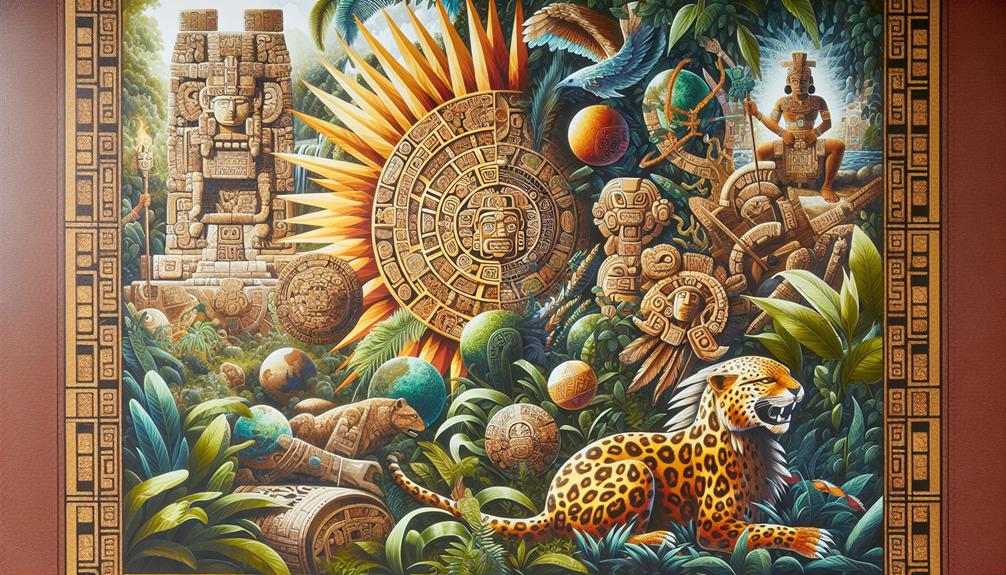24, Sep 2024
Decoding Aztec Symbols: Ancient Meanings and Modern Interpretations
When you start to decode Aztec symbols, you uncover a fascinating world where each intricate design conveys profound meanings, deeply rooted in a rich cultural tapestry. Imagine the sun, not just as a celestial body, but as a crucial force of life, while the serpent embodies the duality of existence. As modern artists reinterpret these ancient symbols, they weave together tradition and contemporary aesthetics, igniting discussions about cultural representation. What does this fusion mean for our understanding of identity and heritage today? You might find the answers surprising.

Overview of Aztec Symbolism
Aztec symbolism is a vibrant tapestry woven with intricate images and meanings that reflect the culture’s beliefs, rituals, and worldview.
When you explore this rich symbolism, you’ll discover a fascinating interplay of nature, spirituality, and daily life. Each symbol serves as a window into the Aztec mindset, revealing how they understood their place in the cosmos.
The Aztecs viewed the world as interconnected, where every element, from the sun to the serpent, held significance. The symbols often represent dualities, such as life and death, or war and peace, underscoring their belief in balance. This dual nature illustrates the complexities of existence and the importance of harmony in their society.
As you probe deeper, you’ll notice that color played a critical role in their symbolism, with each hue representing different elements, directions, and deities. The Aztecs also used symbolism in their architecture, art, and rituals, creating a holistic view of their universe. Understanding these symbols not only enhances your appreciation of Aztec culture but also connects you to the profound wisdom embedded in their history.
Key Aztec Symbols and Their Meanings
Exploring the key symbols of the Aztec civilization reveals a world rich in meaning, where each image encapsulates profound beliefs and cultural narratives. The sun, for instance, represents the life-giving force, often depicted as a radiant disk, symbolizing warmth and sustenance. You’ll find the eagle soaring high, emblematic of strength and valor, frequently associated with the sun god, Huitzilopochtli.
Another significant symbol is the jaguar, representing power and the Night. In Aztec mythology, the jaguar embodies the warrior spirit, revered for its stealth and ferocity. The serpent, particularly the feathered serpent Quetzalcoatl, signifies the duality of life—earthly and celestial—blending the physical and spiritual domains.
The maize plant, essential to Aztec sustenance, symbolizes life and fertility, reflecting the importance of agriculture in their society. Finally, the heart is a powerful symbol of sacrifice, vital in their religious rituals, showcasing the belief in giving life for the greater good.
Each of these symbols isn’t just an image; they encapsulate the very essence of Aztec identity, beliefs, and their connection to the universe. Understanding these symbols deepens your appreciation for their rich cultural heritage.
Modern Interpretations and Relevance
Drawing inspiration from ancient designs, contemporary artists and designers are reinterpreting Aztec symbols to reflect modern themes of identity, resilience, and cultural pride. You’ll notice vibrant murals and textiles adorned with these symbols, often merging traditional motifs with contemporary aesthetics. This fusion creates a powerful dialogue between the past and present, showcasing how these ancient emblems can still resonate today.
In fashion, you might spot clothing lines featuring Aztec patterns that celebrate indigenous heritage, encouraging wearers to connect with their roots. Jewelry designers are also embracing these symbols, turning them into statement pieces that honor ancestral stories while appealing to modern sensibilities.
Social media plays a pivotal role in this revival, as influencers and artists share their interpretations, sparking conversations about cultural significance and representation. You’re not just seeing symbols; you’re witnessing a reclaiming of identity and a celebration of diversity in a globalized world.
As you explore these modern interpretations, you’ll find that Aztec symbols are more than mere decorations—they’re a reminder of resilience and an invitation to honor the rich tapestry of human experience.
Explore Further: The World of Aztec Symbols
The symbols of the Aztec civilization carry profound meanings, both ancient and modern, reflecting their complex worldview and cultural heritage. Decoding these symbols offers a fascinating journey into the past, revealing insights into their beliefs, practices, and artistic expressions. To delve deeper into the enigmatic world of Aztec symbols, we invite you to read a detailed article on aztec symbols. This comprehensive piece explores their significance and interpretations, providing a deeper understanding of this ancient civilization’s rich iconography.
- 0
- By Maria Williams



